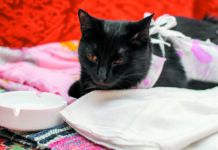If Car Rides Nauseate Your Cat
Cats tend to hate car rides for all kinds of reasons, but for some cats, one of them may be motion sickness. A glitch in a cat’s vestibular system, which controls balance and coordinates the movements of the head and eyes, may have something to do with it. But the sheer terror of riding in a car can bring on motion sickness, too, with its attendant vomiting, drooling, diarrhea, and caterwauling—loud, tormented hyper vocalizations.
Bird Flu Becomes a Feline Threat, Even for Indoor Cats
Since March of last year, more and more cats have been diagnosed with bird flu, an often deadly viral disease. Cats in particular appear susceptible to avian influenza. The illness has been diagnosed in indoor cats, barn cats, and large cats like tigers, mountain lions, and lynx, both in zoos and in the wild.
Between Dying and Death, There’s Hospice
What people tend to think of when their cat has an illness with a grim prognosis is “a kind of binary option, either full-court treatment or euthanasia,” says Eric Richman, MSW, LICSW, a veterinary social worker who tends to clients at Tufts. But there’s “potential for middle ground,” he says, in the form of hospice and palliative care—“palliative” meaning pain-relieving as opposed to disease-treating.
Keep It Down at the Vet’s Office
Cats’ blood pressure and respiratory rates can increase in veterinary settings in response to lots of noise, making what they consider a difficult situation more difficult still. Researchers at Ontario Veterinary College assessed more than 30 cats examined both quietly and against the backdrop of tapes on which people talked and laughed at 80 decibels—as loud as a garbage disposal or a busy downtown street. Average heart rates went from 155 beats per minute during the quiet exams to almost 200 beats per minute when the tapes were played. Respiratory rate—the number of breaths taken per minute—soared from about 48 to an average of 61. Bodily reactions indicating stress— dilated pupils and the like—increased, too.
How Long Can a Cat Be Left Alone in the House?
The general rule for how long it’s okay to leave a cat alone at home is 24 hours. Many cats even seem to do fine alone for an entire weekend. When their people come back in the house, they may be greeted with nothing more than a nonchalant yawn, if that much.
Feline Grace: It’s an Anatomy Thing
There’s a reason the average cat can sprint up to 20 miles an hour (and sometimes 30) while human athletes—those who really use their bodies—have a significantly slower average sprint speed of only 15 miles an hour. Cats don’t allow themselves to get bogged down by friction—or gravity. At certain points when a cat runs, she is completely aloft, with all of her legs in the air. Even when a cat is running on the ground, her flexible spine can alternately arch and straighten in a way that gives her incredible stride. Her movements have the beauty of an Olympiad’s.
Copper disease
Q: My cat was pretty sick—vomiting, no lust for life, weight loss, abdominal distention. The vet did some testing, first with a blood test and then with a liver biopsy, and said she had copper disease. Too much of that mineral had accumulated in her liver. The doctor said my cat would need medicines and should go on a low-copper diet. How could this have happened? I have always fed her food that met the standards of the Association of American Feed Control Officials, as you suggest people do.
Scruffing a Cat to Get Him to Cooperate: A Bad Idea
There’s a reason cats have loose skin on the back of the neck. Called the scruff, that skin is what a new mother uses to pick up her kittens and move them to a different spot, if necessary. It more or less shuts a kitten down, making her unable to resist handling. By the time a kitten is a couple of months old, the mother cat stops corralling her that way. It’s just for the very beginning of a cat’s life.
Why cats like to sink into sinks
Q: Why do cats like to hang out in sinks? I have had more than one that does that.
Ricardo Faldi
Huntington, New York
Download The Full February 2025 Issue PDF
- Cats Get Winter Skin, Too
- Morsels
- How Frail Is Your Cat?
- 7 Ways to Improve Your Relationship with Your Cat
- About That Pet Food
- The Myth of the Hypoallergenic Cat
- More Consistent Testing for Heartworm Disease Advised for Cats
- Dear Doctor
Cats Get Winter Skin, Too
Just as your own skin might require moisturizer during the cold months, so might your cat’s. It’s the dry heat in people’s homes that does it. Inside environments tend to have much less moisture (lower humidity) to keep skin well hydrated when the heat is cranked up.
Increased Thirst? Time for a Doctor’s Appointment
If it’s summertime and your cat laps up a lot of water right after sunning herself, she’s probably just feeling thirsty after lounging in the heat. But if you’ve been noticing increased thirst in general and it has nothing to do with the weather, there’s a reasonable chance it could be attributable to one of three medical conditions: kidney disease, overactive thyroid [hyperthyroidism], or diabetes.















